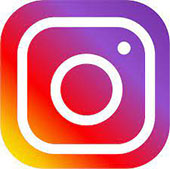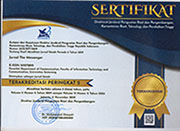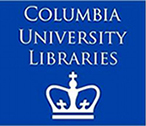The Influence of Social Media on Millennial Generation about Travel Decision-Making
Abstract
The presence of the millennial generation in the world of tourism has different characteristics from the previous generation. They are not interested in commercial advertising but prefer a User-Generated Content (UGC) approach and influence in their social environment. The purpose of this research is to determine the influence of social and UGC on Instagram on millennial generation travel decision-making. Instagram was chosen because 67% of travelers use Instagram for travel inspiration before booking a trip and after a trip is booked, and continue to use it for future trips. The sample of this study was 384 millennial respondents in the Greater Jakarta area because it had the demographic bonus and the most productive age. The results show that UGC on Instagram is highly trusted as a media for millennial tourism decision-making because it is authentic and reliable. This research also succeeded in answering the phenomenon which states that the millennial generation can change the tourism industry. This finding is useful for destination managers and the government in their efforts to increase the promotion of tourist destinations to the millennial generation with the Instagram user-generated content approach.
Keywords
Full Text:
PDFReferences
Ahlgren, M. (2019). Instagram statistics & facts. Statistic. https://www.websitehostingrating.com/instagram-statistics/
Amalia, J., & Hanika, I. (2021). Tourism in Digital Era: The Influence of Digital Marketing on the Intention to Visit Museum. Malaysian Journal of Communication, 37(3). https://doi.org/10.17576/jkmjc-2021-3703-16
Ambardar, A., & Malik, H. (2019). Impact of Consumer-Generated Content (CGC) on Travel-Related Decisions. Handbook of Research on International Travel Agency and Tour Operation Management. Handbook of Research on International Travel Agency and Tour Operation Management, 13. https://doi.org/10.4018/978-1-5225-8434-6.ch015
Anubha, A., & Shome, S. (2021). Intentions to use travel eWOM: mediating role of Indian urban millennials attitude. International Journal of Tourism Cities, 7(3), 640 661. https://doi.org/10.1108/IJTC-04-2020-0073
Badan Pusat Statistik Republik Indonesia. (2019). Statistik pemuda Indonesia 2019.
Blackshaw, P., & Nazzaro, M. (2006). Consumer-generated media (CGM) 101: Wordof-Mouth in the Age of the Web-Fortified Consumer. Nielsen Buzz Metrics.
Choi, S., & Insin, K. (2019). Travelers parasocial interactions in online travel communities. Journal of Travel & Tourism Marketing, 35(2), 888 904.
Cox, C., Burgess, S., & Buultjens, J. (2009). The Role of User-Generated Content in Tourists Travel Planning Behavior. Journal of Hospitality Marketing & Management, 18, 743 764. https://doi.org/ 10.1080/19368620903235753
Daugherty, T., Eastin, M. S., & Bright, L. F. (2008). Exploring Consumer Motivation for Creating User-Generated Content. Journal of Interactive Advertising, 8(2), 6 25. https://doi.org/10.1080/15252019.2008.10722139
DeGruttola, M. (2019). Stackla Survey Reveals Disconnect Between The Content Consumers Want & What Marketers Deliver. Stackla.
Dillon, B. (2016). Marketing Travel To Millennials: Is Social Media The Ticket? Retrieved from the University of Minnesota Digital Conservancy. Strategic Communication Capstone Projects, 143(07). https://hdl.handle.net/11299/181553
Effendy, O. U. (2003). Ilmu, Teori, dan Filsafat Komunikasi. Citra Aditya Bakti.
Forevervacation. (2020). How Social Media Is Changing The Way We Travel. Case Study.
Gait ´an, J., Sanz-Altamira, B., & Ram rez-Correa, P. (2019). Complexity of Understanding Consumer Behavior from the Marketing Perspective. Hindawi Complexity Journal, 3(9).
Gretzel, U., & Yoo, K. H. (2008). Use and Impact of Online Travel Reviews. Proceedings of the International Conference in Innsbruck, 35 46. https://doi.org/10.1007/978-3-211-77280-5_4
Griffin, E. (2012). In a First Look at Communication Theory (8th ed.). Mc Graw Hill.
Hakim, I. N. (2019). Media Promosi yang Ramah Wisatawan Milenial. Jurnal Kepariwisataan Indonesia, 13(2), 1 23. https://doi.org/10.47608/jki.v13i22019.1-23
Helal, G., & Ozuem, W. (2019). Social Media and Social Identity in the Millennial Generation. In Leveraging Computer-Mediated Marketing Environments. IGI Global Publisher of Timely Knowledge. https://doi.org/10.4018/978-1-5225-7344-9.ch00
Kartajaya, H. (2008). On positioning. Mizan.
Katz, E., Blumler, J. G., Gurevitch, M., & Hass. (1974). Utilization Of Mass Communication By The Individual, The Uses Of Mass Communication: Curent Perspective On Gratification Research. SAGE Publication.
Kementerian Pemberdayaan Perempuan dan Perlindungan Anak Indonesia. (2018). Statistik Gender Tematik: Profil Generasi Milenial Indonesia. Kementerian Pemberdayaan Perempuan Dan Perlindungan Anak. Kementerian Pemberdayaan Perempuan dan Perlindungan Anak Indonesia.
Ketter, E. (2021). Millennial travel: tourism micro-trends of European Generation Y. Journal of Tourism Futures, 7(2), 192 196. https://doi.org/10.1108/JTF-10-2019-0106
Kocak, E., Nasir, V., & Turker, H. (2020). What drives Instagram usage? User motives and personality traits. Emerald Group Publishing Limited, 44(3), 625 643. https://doi.org/10.1108/OIR-08-2019-0260
Kriyantono, R. (2010). Teknik Praktis Riset Komunikasi. Kencana Perdana.
Lee, E., Ah, L., Jang Ho, M., & Yongjun, S. (2015). Pictures Speak Louder than Words: Motivations for Using Instagram. Mary Ann Liebert, Inc, 18(9). https://doi.org/10.1089/cyber.2015.0157
Liu, D., Wang, K., Mao, T., & Yang, C. (2021). The Impact of Instagram Stories on Tourists Consumption Behavior in Smart City Night Markets. Hindawi Journal, 2(3), 1 11. https://doi.org/10.1155/2021/5509265
Macdonald, L. (2019). 5 Statistics That Prove Social Media Will Influence Your Next Travel Destination. Stackla.
Manyevere, R. M. (2019). The Role of Social Media Sites in Trip Planning and Destination Decision-Making Processes. African Journal of Hospitality, Tourism and Leisure, 8(5). ISSN: 2223-814X
Mathieson, A., & Wall, G. (1982). Tourism: Economic, Physical, And Social Impacts. Longman Group Limited.
McQuail, D. (2010). Teori Komunikasi Massa. Salemba Humanika.
Morissan. (2013). Teori Komunikasi: Individu Hingga Massa. Prenada Media Group.
Mosquera, A. (2018). Key Factors for In-Store Smartphone Use in an Omnichannel Experience: Millennials vs. Nonmillennials. Hindawi Complexity Journal, 3(5).
Nurudin. (2014). Pengantar Komunikasi Massa. Rajagrafindo Persada.
Prisgunanto, I. (2020). Social Media and Visit Decision to Tourist Destinations: Measuring the Impact of Instagram on Expatriates in Indonesia. Malaysian Journal of Communication, 36(1).
Rachmadi, H. (2016). Model Pengambilan Keputusan Berwisata. Jurnal Media Wisata, 14(2), 396 414. https://doi.org/10.36276/mws.v14i2.249
Rakhmat, J. (2005). Psikologi Komunikasi. PT. Remaja Rosdakarya.
Risnita. (2012). Pengembangan Skala Modern Likert. Jurnal Edu Bio, 3(1), 86 99.
Ruggiero, T. E. (2000). Uses and Gratifications Theory in The 21st Century. Mass Communication & Society, 3, 3 37. https://doi.org/10.1207/S15327825MCS0301_02
Sangadji, E. M., & Sopiah. (2013). Perilaku Konsumen Pendekatan Praktis disertai Himpunan. Jurnal Penelitian Andi, 2(7). https://doi.org/ISBN: 978-979-29-3575-2
Sangadji, Etta Mamang, & Sopiah. (2013). Perilaku Konsumen Pendekatan Praktis disertai Himpunan. Jurnal Penelitian Andi. ISBN: 978-979-29-3575-2
Satyadewi, A. J., Hafiar, H., & Nugraha, A. R. (2017). The Selection of The Instagram Social Media Account by Holiday Inn Bandung. Jurnal The Messenger, 9(2), 153 162.
Schiffman, & Kanuk. (2015). Consumer Behavior (11th ed.). Prentice Hall.
Schweiger, W., & Quiring, O. (2007). User-Generated Content Auf Massenmedialen Websites - Eine Spielart Der Interaktivit ¤t Oder Etwas V ¶llig Anderes? –konomische Herausforderungen Der Onlinekommunikation, 97 122. ISBN 3-88927-416-1
Senayake, S. (2020). The influence of social media on millennial travellers. LAP LAMBERT Academic Publishing.
Siegel, L., & Wang, D. (2018). Keeping up with the joneses: emergence of travel as a form of social comparison among millennials. Journal of Travel & Tourism Marketing, 36(2), 159 175.
Simamora, B. (2004). Panduan Riset Perilaku Konsumen. Gramedia Pustaka Utama.
Sirakaya, E., & Woodside, A. G. (2005). Building and Testing Theories of Decision Making by Travellers. Tourism Management, 26, 815 832. https://doi.org/10.1016/j.tourman.2004.05.004
Siregar, S. (2013). Metode Penelitian Kuantitatif: Dilengkapi Dengan Perbandingan Perhitungan Manual dan SPSS. Kencana.
Sofronov, B. (2018). Millennials: a New Trend for The Tourism Industry. Annals of Spiru Haret University, 18(3), 109 122. https://doi.org/ 10.26458/1838
Song, B. L., Liew, C. Y., Sia, J. Y., & Gopal, K. (2021). Electronic word-of-mouth in travel social networking sites and young consumers purchase intentions: an extended information adoption model. Young Consumers Journal, 22(4), 521 538. https://doi.org/10.1108/YC-03-2021-1288
Statista. (2019). Leading countries based on many Instagram users. Statistic. https://www.statista.com/statistics/578364/countries-with-most-instagram-users/
Styv ©n, M. E., & Foster, T. (2018). Who am I if you can t see me? The self of young travellers as driver of eWOM in social media. Journal of Tourism Futures, 4(1), 80 92. https://doi.org/10.1108/JTF-12-2017-0057
Syrett, M., & Lamminman, J. (2004). Advertising and millennials. Young Consumers: Insight and Ideas for Responsible Marketers. Emerald Group Publishing Limited, 5(4), 62 73. https://doi.org/10.1108/17473610410814355
Terttunen, A. (2017). The Influence of Instagram On Consumers Travel Planning and Destination Choice. University of Applied Sciences.
Veiga, C., Santos, M. C., guas, P., & Santos, J. A. C. (2017). Are millennials transforming global tourism? Challenges for destinations and companies. Worldwide Hospitality and Tourism Themes, 9(6), 603 616. https://doi.org/10.1108/WHATT-09-2017-0047
Wrede, O. (2016). Continuity in travel information. Information Design Journal, 22(2), 172 178. https://doi.org/10.1075/idj.22.2.09wre
XuXu, & Pratt, S. (2018). Social media influencers as endorsers to promote travel destinations: an application of self-congruence theory to the Chinese Generation Y. Journal of Travel & Tourism Marketing, 35(7), 958 972. https://doi.org/10.1080/10548408.2018.1468851
DOI: http://dx.doi.org/10.26623/themessenger.v13i3.2328
Refbacks
- There are currently no refbacks.
Copyright (c) 2021 Jurnal The Messenger
View My Stats [Jurnal The Messenger] is an International Scientific Journal, Published by the Department of Communication, Faculty of Information Technology and Communication, Universitas Semarang (Central Java, Indonesia). It is licensed under a Creative Commons Attribution 4.0 International License.



_11.jpg)




_BARCODE.jpg)
_BARCODE1.jpg)


5.png)










2.png)





